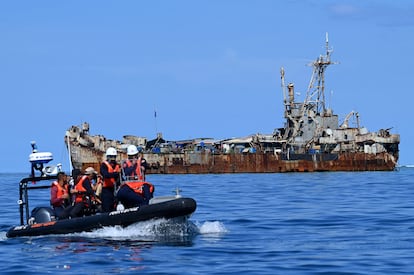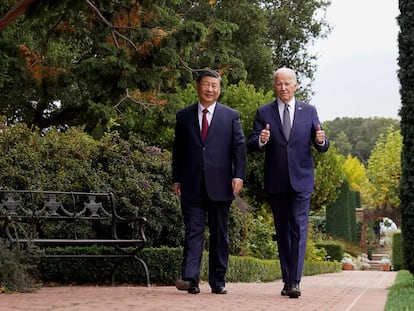A relic from World War II is all that is preventing a Chinese advance in the South China Sea
Beijing is demanding that the Philippines tow the disintegrating ship to port, but Manila insists on keeping it on the Ayungin atoll as an outpost to maintain its interests in the disputed Spratly archipelago


In the middle of the crystalline waters speckled with reefs and sandbars that make up the Spratly Islands in the South China Sea, the Sierra Madre — an old American World War II ship — lies stranded. The rusty, pockmarked hulk has a long and tortuous history. In 1999, when it had been in the service of the Philippine Navy for two decades, the government in Manila decided to run it aground on the Ayungin atoll (also known as Second Thomas Shoal), a spit of sand that breaks the ocean’s surface about 105 nautical miles west of the Philippine province of Palawan. The island nation claims sovereignty over this disputed archipelago, since it is located within its exclusive economic zone (EEZ), and the ship has become an outpost against China’s strength in the area and a metaphor for a great geopolitical battle.
Technically, the Sierra Madre is still an active warship as Manila maintains a small military garrison on board. The detachment is often surrounded by Chinese ships that patrol the area to try to reaffirm their presence. To survive the isolation, the handful of Filipino troops try to prevent further deterioration of the ship that is so damaged that it looks like something out of a post-apocalyptic movie. Various journalists who have come on board have documented how the water has penetrated the interior, how everything is covered in rust, how the military improvises harpoons for fishing, how lonely the men are. Pounded by water, wind and salt, the complete disintegration of the Sierra Madre would make Philippine interests in the area difficult to maintain and would most likely trigger an immediate response from Beijing.
The Asian giant claims 90% of the waters of the South China Sea for “historical reasons”. That includes the Ayungin atoll, which it calls Ren’ai Jiao. It considers the atoll part of its territory and believes that by sending a military ship to “land” on the shoal, the Philippines seriously violated its territorial sovereignty. The Chinese maintain their claim to the atoll despite the fact that a ruling by the Permanent Court of Arbitration in The Hague in 2016 dealt a blow to Beijing by unanimously denying the legal basis for its arguments. The People’s Republic has always questioned the authority of the decision.
“We urge the Philippines to tow away the illegally stranded warship as soon as possible and refrain from undermining peace and stability in the South China Sea,” the Chinese Foreign Ministry complained in October.
The stranded ship lies at the epicenter of a very complex case in international maritime law and is, at the same time, the uncomfortable stone in Beijing’s shoe that is preventing it from deploying its military in the Spratly Islands. China has been extending its dominance in the archipelago — where the interests of many countries collide, including China, Malaysia, and Vietnam, in addition to the Philippines — with the construction of artificial islands and military installations. This has resulted in strained relations with neighboring countries and irritation in Washington, which sees it as another example of growing Chinese assertiveness.
Huge symbolic value
The Philippine ship “has enormous symbolic value, because it is proof of Philippine jurisdiction over its EEZ and continental shelf,” explains Jay L. Batongbacal, professor at the University of the Philippines College of Law and director of the university’s Institute of Maritime Affairs and Law of the Sea. Based on the 2016 arbitration, he says via email, the Philippines “has the right to manage, exploit, conserve and protect its resources.” And he adds that it is not that the Philippines claims sovereignty over the sandbar based on the ship having run aground there. “Rather, it asserts its rights as a coastal state with exclusive sovereign rights.”
Built in 1944 in Indiana in the United States as a tank landing ship, and originally launched under the name LST-821, the vessel was assigned to the Pacific theater of operations during World War II in preparation for a possible invasion of Japan. There she won a battle star for her war work. During the Vietnam War, she was refitted as a floating base in the Mekong Delta, where her crew was distinguished for their “extraordinary heroism,” as reconstructed by Jonathan L. Hoppe in an article from the United States Naval Institute. “The old LST [tank landing ship] had a long and decorated career spanning three navies and multiple continents over five decades.”
In 1969, as part of a U.S. military assistance program, she was transferred to the Navy of South Vietnam to participate in that country’s war with the communist North Vietnam, against whom Washington’s troops were also fighting. With the fall of Saigon, the ship was forced to flee with 3,000 refugees on board. She left Vietnam as part of a flotilla carrying thousands of people. The Philippines allowed the refugee ships to dock and disembark in its ports in exchange for them becoming part of its navy in the future. This happened in 1976. Under the orders of the Philippine government, she was renamed Sierra Madre, in honor of the longest mountain range in the Philippines, and served as an amphibious ship until the government decided to run her aground in the Ayungin atoll. “Though her hull is now pockmarked with gaping holes, and she is for all intents and purposes no longer seaworthy, the Sierra Madre remains in service and is, therefore, an official extension of sovereign Philippine territory,” Hoppe writes.
Sparks often fly in this highly volatile region, through which a third of the world’s maritime trade passes. In October, for example, a collision took place between Chinese ships patrolling Ayungin atoll and two Philippine ships, which entered the area on a “regular and routine rotation and resupply” mission to the Sierra Madre. They were bringing supplies and a fresh military contingent that are key to the ship’s survival. According to Manila’s version, a Chinese Coast Guard ship caused a collision with the supply ship contracted by the Philippine Armed Forces. Later, a Philippine Coast Guard ship “was hit by a Chinese maritime militia vessel.” Beijing, on the other hand, argued that the Philippine vessels “ignored warnings” and “dangerously collided with Chinese Coast Guard vessels” that were “carrying out order maintenance tasks at the site.” Chinese authorities claimed they were trying to stop Philippine ships carrying “illegal construction” materials.
After this latest clash, Washington reminded those involved that the mutual defense treaty signed in 1951 with Manila “extends to armed attacks against the Philippine Armed Forces, civilian ships, and aircraft — including those of its Coast Guard — in any part of the South China Sea,” and reiterated its condemnation of China’s “expansive and illegal maritime claims” in the area.
Although clashes subsided during the years that Rodrigo Duterte — who was closer to Beijing — was president of the Philippines, the altercations at different points have gained greater prominence since 2022, after Bongbong Marcos, son of the dictator Ferdinand Marcos and his wife, Imelda, came to power. He has pivoted away from China and intensified the country’s military relationship with the United States. The skirmishes in these waters were part of the discussions between the Chinese president, Xi Jinping, and the American president, Joe Biden, during their meeting last week in San Francisco, in which they agreed to resume high-level military communications with each other in order to prevent misunderstandings. This week, Washington and Manila have begun joint military exercises in the area, in another sign of their growing ties in the face of a situation that Marcos Jr. has described as “more serious than it was before.”
There is growing pressure from China on the outpost, with “increasingly intense attempts to prevent the Philippines from replenishing the sandbar,” according to Batongbacal, the jurist specializing in maritime law. “They are trying to prevent any attempt to repair or shore up the rusting ship, probably hoping it will sink very soon.”
But for Manila keeping the ship in place is key. “If the old ship disintegrates, the Philippines could have difficulty maintaining its outpost,” he continued. “China could use such an event as an excuse to intervene and remove the Philippine troops from the sandbar, as well as destroy the ship. If it does, it is also likely that it will cordon off the sandbar thereafter and prevent the return of Philippine troops or ships ever again.”
Sign up for our weekly newsletter to get more English-language news coverage from EL PAÍS USA Edition
Tu suscripción se está usando en otro dispositivo
¿Quieres añadir otro usuario a tu suscripción?
Si continúas leyendo en este dispositivo, no se podrá leer en el otro.
FlechaTu suscripción se está usando en otro dispositivo y solo puedes acceder a EL PAÍS desde un dispositivo a la vez.
Si quieres compartir tu cuenta, cambia tu suscripción a la modalidad Premium, así podrás añadir otro usuario. Cada uno accederá con su propia cuenta de email, lo que os permitirá personalizar vuestra experiencia en EL PAÍS.
¿Tienes una suscripción de empresa? Accede aquí para contratar más cuentas.
En el caso de no saber quién está usando tu cuenta, te recomendamos cambiar tu contraseña aquí.
Si decides continuar compartiendo tu cuenta, este mensaje se mostrará en tu dispositivo y en el de la otra persona que está usando tu cuenta de forma indefinida, afectando a tu experiencia de lectura. Puedes consultar aquí los términos y condiciones de la suscripción digital.
More information
Archived In
Últimas noticias
There is as much life left to discover on planet Earth as that which is already known
Dozens presumed dead, around 100 injured in fire at Swiss Alps bar during New Year’s celebration
Is porn for women different from conventional porn? We spoke to those who make it
Cartagena de Indias is sinking: What can the city do to mitigate it?
Most viewed
- David King, chemist: ‘There are scientists studying how to cool the planet; nobody should stop these experiments from happening’
- Reinhard Genzel, Nobel laureate in physics: ‘One-minute videos will never give you the truth’
- Oona Chaplin: ‘I told James Cameron that I was living in a treehouse and starting a permaculture project with a friend’
- Sinaloa Cartel war is taking its toll on Los Chapitos
- The Interoceanic Train, the Mexican alternative to the Panama Canal










































